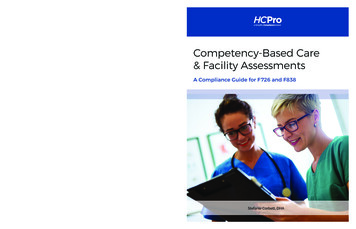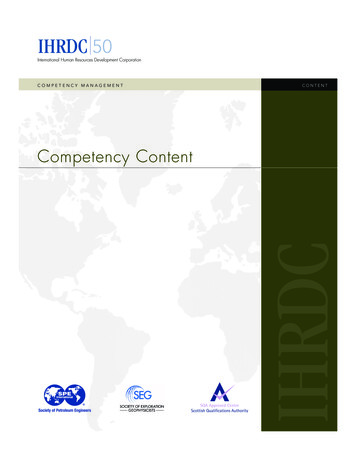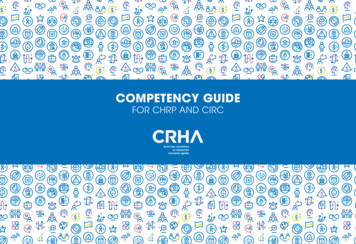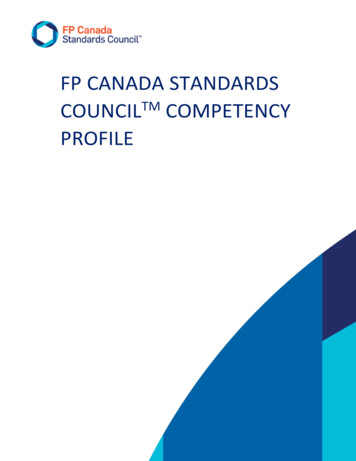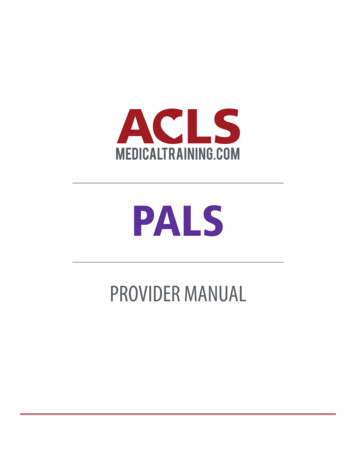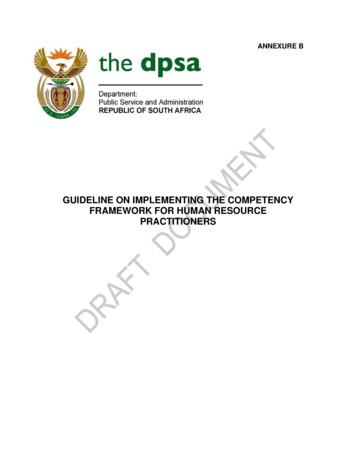
Transcription
ANNEXURE BGUIDELINE ON IMPLEMENTING THE COMPETENCYFRAMEWORK FOR HUMAN RESOURCEPRACTITIONERS
CONTENTS1. Introduction1.1Background1.2Purpose with the Guide2. Overview of the competency framework for HRM&D Practitioners2.1The competency dictionary2.2Definition of competencies3. Integrating competencies with HRM&D practices3.13.23.33.43.5The linkages between Job analysis, Job profile and EmployeeprofileRecruitment and selectionTraining and developmentPerformance managementHR Planning4. Linkages with the leadership and management competency framework5. Conclusion2
1.INTRODUCTION1.1 BackgroundThe dpsa undertook a study to identify interventions to improve the HRMfunction in the Public Service. The study focused on areas such as the roles ofHR components and the competencies required to fulfil those roles. Thecompetency framework was subsequently designed with the intention to supportinterventions to improve the HRM function in the Public Service.Competency frameworks are widely used by different organisations to help themidentify the essential skills, knowledge and personal characteristics required forsuccessful performance in a job. Chapter 1, Part III.I.4 of the Public ServiceRegulations, 2001 stipulates that the Minister for Public Service andAdministration may provide advice on: the possible job content;the necessary and desirable competencies for the job;indicators of those competencies; anddesirable characteristics for employment.1.2Purpose with the guideThis guide is issued in support of the competency framework for human resourcemanagement and development which was made available to departments perthe DPSA circular 14/1/1P dated 6 August 2008.The purpose of the guide is to assist with understanding the roles and responsibilities of HR practitioners inrepositioning the HR function to render support on a strategic level and toensure that HR is assisting departments to achieve their strategic goals serve as a practical tool to support HR practitioners and managers toeffectively utilise the competency framework in accordance to their needs andcircumstances; and provide an instrument that will enable HR practitioners and managers tointegrate the competency framework with HRM&D practices contextualize how the competency framework can be used to complementand improve some of the established HRM&D practices such as, recruitmentand selection, training and development, performance management, etc.3
The intention is that the guide should be as practical and user friendly aspossible. As the use of competency frameworks evolves, the guide will beupdated and improved on a continuous basis.The competency framework for human resource management and developmentdoes not exist in isolation and must at all times be used in conjunction with theleadership and management competency framework.2.OVERVIEW OF THE COMPETENCY FRAMEWORK FOR HRM & DThe competency framework consists of two main groups of competencies,namely the behavioural competencies and the functional competencies. Thesecompetencies are described in more detail in the competency dictionary thatconsists of two parts. The first part deals with the behavioural competenciesreflecting the desired attributes and the second part consists of the technicalcompetencies that provide for different levels of complexity described in terms ofproficiency levels.2.1 The competency dictionary:2.1.12.1.2PART 1: Behavioural competencies, which consist of: 21 competencies classified into two categories of emotionalcompetencies and professional conduct each competency has a title and definition the competencies are further defined in terms of the desiredattributes which describes the qualities of character requiredto be an effective and successful performer in the job.PART 2: Functional competencies, which consist of: 36 competencies classified into five HR functional areas HR Organizational Strategy and PlanningHR Practices and AdministrationHR utilization and Capacity developmentEmployee Health and WellnessEmployee Relations and People Managementeach competency has a title and definition4
each competency is described in terms of the proficiencylevels and has a collection of related behavioural indicators.It is not possible to provide examples of all behaviours thatcould be observed within a competency. The behaviours thatare included generally indicate the type of behaviour that isexpected to be observed, hence, behavioural indicators.2.2 Definition Of CompetenciesCompetencies are a mixture of skills, knowledge and attributesdisplayed in the behaviour or actions that individuals demonstrate whenundertaking job relevant tasks effectively within a given organisational context.The two main themes in the definition are Descriptions of work tasks, ie, what an individual has to do in a jobDescriptors of behaviour, ie, how an individual does their jobAn ability based on work tasks is usually referred to as a ‘competence’ (whatindividuals have to achieve) whilst an ability based on behaviour is usuallyreferred to as a ‘competency’ (how individuals have to achieve). The focus ofcompetences is on the job/ role and competencies focus on the person.In practice, a mixture of tasks, job outputs and behaviours are included asdescriptors of competencies. The competencies in the competency framework forHRM&D constitute a blend of tasks, outputs and behaviours.3.INTEGRATING COMPETENCIES WITH HRM&D PRACTICES3.1 The linkages between Job analysis, Job profile and worker profileIt is important to recognize the close linkages that competency frameworks havewith other processes in the workplace to accurately design and define the jobrequirements. In this regard the integration between job analyses and thedevelopment of a job and worker profiles is summarized in diagram 1 below.5
JOB ANALYSISGathering detailedinformation about thedifferent factorsrelating to jobsWORKER PROFILEHuman attribute profileFunctional competencyprofileJOB PROFILEJob objectivesJob descriptionIdentify and collectjob relevantcontextualizingfactors andperformancemeasuresValidityIdentify and apply jobrelevant assessmentmethodsOUTCOMEHigh performance workforceJob AnalysisMany decisions in the human resources field rely on information about jobs. Jobanalysis is a systematic process for collecting and analyzing this information.A thorough job analysis enables the documenting of the tasks that are performedon the job, the situation in which the job is performed and the human attributesneeded to perform the job. Information about jobs can be used to develop a jobprofile (job description, job objectives) and worker profile (competencies).In practice this information can assist in improving the screening of applicants fora job, we need to know what attributes (knowledge, abilities, experience, etc)they should possess in order to perform the job tasks effectively and within theestablished organisational climate.In conducting job analysis, the following should be considered:6
All of the duties and responsibilities of the positionThe scope and level of the jobThe context in which these are to be performedThe amount of responsibility, authority and accountability required toperform the jobThe major and minor activitiesJob DescriptionChapter 1, Part III.I.1 of the Public Service Regulations stipulates that jobdescriptions should be based on the main objectives of the jobs, indicate theinherent requirements of the job and reflect an appropriate emphasis on servicedelivery.A job description is a clear, concise depiction of a job’s responsibilities andinherent requirements. It is based on the findings of job analysis. A wellconstructed job description can be used to support most HR functions, e.g, jobevaluation, performance evaluations, recruitment, selection, work plans, trainingand development. It encourages and fosters a deeper understanding of the rolesand responsibilities of the post as it provides the link between expected outputsand competencies required to perform successfully.The following components should be considered when developing a competencybased job profile:Job purpose (reason why the post was created)Clarify the overall purpose of the job. This is a brief statement of the contributionthat the job makes to the department.Example of a job purpose:Job; Deputy Director: Employment RelationsTo manage employment relations processes in the department.Key activitiesHaving identified the job purpose, the next step is to identify the key activities thatmust be performed effectively in order that the job purpose can be achieved.Example of key activities:Job; Deputy Director: Employment Relations7
Develop, implement and maintain employment relations policies, guidelinesand procedure manualsProvide employment relations advisory and support servicesManage collective bargaining processesFacilitate grievances and disciplinary hearings and advise on correct anddue processes to be followedProvide and facilitate training and development interventionsManage resources (e.g, human and financial)Compile reports and submissions to managementCompetency weightingsKey activities are then used to produce weightings for the importance ofcompetencies for the role. Each competency has three proficiency levels and alllevels have associated behavioural statements describing how that particularlevel is distinct from other levels within that competency. Therefore, thestandards of competence differ in the context of the three levels within aparticular job category.The proficiency levels are not linked in a one to one relationship to job levels. Forexample, proficiency level one should not be regarded as to be applicable to therole of HR practitioner and proficiency level two to that of HR specialist. Such anapproach will be counter productive for two reasons. Firstly, although there isusually some connection between proficiency levels and seniority of a job, it isnot always so. For example, a senior HR position may not require the job holderto have the highest level of proficiency for skills development facilitationcompetency, whereas a skills development facilitator who occupies a specialistrole may.The second way in which linking proficiency levels so directly with job levels iscounter productive is that a lot of time can be spent trying to distinguish thedifferent behavioural statements for each job level, whilst in reality, somebehaviours actually overlap. The proposed approach is to link the proficiencylevels with the key activities of a position.The following type of grid can be used to indicate how critical each proficiencylevel is for each key activity. The level of proficiency identified on the rating scaleis likely to be the level required for the profile. The same weighting processshould be done using the leadership and management competency framework.8
Table 1: Example of competency weightings:Job; Deputy Director: Employment RelationsKeyactivitiesTechnical competencies and proficiency vellevel1233.ManagingdisputesProf ProfProflevel levellevel123xx3. Facilitategrievancesanddisciplinaryhearingsand adviseoncorrectanddueprocesses tobe followedxx4.Provideand facilitatetraining anddevelopmentinterventionsxx1. Develop,implementand roceduremanuals2. ManagecollectivebargainingprocessesxxThe table below provides an example of how to integrate the HR competenciesinto a competency based role profile for the Deputy Director. It will provide foridentifying the competencies required, including the behaviour required in termsof the proficiency level. The leadership and managerial competencies can alsobe addressed in a similar way.9
Table 2: Integrating the HR competencies into a competency based profilePostKey objectivesCompetency profileDeputy To develop, implement and ploymentrelations policies, guidelinesAbility to manage theRelationsand procedure manualsdevelopment of labour Toprovideemployment relations strategy andrelationsadvisoryand plans that underpin thenegotiation approaches.support services TomanagecollectiveAbility to manage thebargaining processesrepresentationofthe To facilitate grievances and department in sectoraldisciplinary hearings and bargaining processes andadvise on correct and due leads the correspondingmandating processes.processes to be followedOtherrequirementsAn appropriatequalification atNQF level 6 ineither rlabourrelationsKnowledge ofthepublicserviceregulatoryframework To provide and facilitate Managingconsultations:training and developmentinterventionsFacilitates the creation of To manage resources (e.g, sound employeremployee relations.human and financial) To compile reports andsubmissions to managementAbility to manage andoversee effective andefficient implementationandcompliancewithlabour laws, ons.Ability to manage thedevelopment of employeerelations strategy andplans that underpin theconsultation approaches. Managing grievances/10
disputes:Ability to empower linemanagers to understandtheir roles andresponsibilities as well asthe employee relationsstrategies.Ability to provide technicalsupport to line managerson the handling ofgrievance proceduresAbility to monitor theutilization of the grievanceprocedures, and to adviceon possible solutions toresolve grievances.Abilitytoinvestigategrievances and act as apresiding officer of anappeal panel. Managing disciplineAbility to facilitate theadministration of disciplinein the department.Assist during disciplinaryinvestigations.3.2 Recruitment and selectionGenerally the recruitment and selection process can be divided into six distinctphases, which includes; job evaluation, advertising, registering applications,screening, short listing and final selection of the most successful candidate(s).Defining and selecting the right competencies during these different phases iscritical to ensure improvement in levels of service delivery. To integrate thecompetency framework with these phases the following should be considered:11
a)Job evaluationTo ensure accurate recruitment and selection practices, the following issuespertaining to the implementation of job evaluation should be considered. b)ensuring that the jobs are clearly defined in a job descriptionjob descriptions must be accurate and updatedjob evaluators need to gain a thorough understanding of the job in terms ofthe key responsibility areas, inherent job requirements and the job outputsthe relative demands of a job (not the amount of work allocated to a post),the complexity, level of responsibility, level of decision making andcompetencies required to carry out the job effectively.AdvertisingThe Public Service Regulations require that a job advertisement clearly sets outthe inherent requirements of the job, which have to be met by applicants(competencies, experience and relevant qualifications). This will assist withcandidates understanding exactly what the job requirements are and will alsoprovide a set of clearly defined selection criteria up front. Further to this, it mayalso assist in reducing the number of non-qualifying applications and ultimatelycontributes to better outcomes in terms of recruitment and selection.Utilising the competency framework will also assist in defining the inherentrequirements of a job without unfairly discriminating against any group of peopleon the basis of subjective criteria such as race, gender, disability, etc as requiredin terms of section 6 (1) of the Employment Equity Act, 1998 and Chapter 1, PartVII.C.1 of the Public Service Regulations, 2001.Defining the inherent requirements of the job rigidly in the form of specificeducational qualifications or years of experience may prejudice some candidates.The result is often that potentially suitable candidates, particularly fromdisadvantaged backgrounds are discouraged or excluded from applying. Suchcandidates might not possess the specific academic qualifications or have therequired years of experience, but could have the acquired the requiredcompetencies through practical work experience. The competency frameworkcan also be used with success in justifiable cases where it is not necessary tounduly emphasize academic requirements but to be very specific in terms ofbehavioural requirements. This is in line with what is contemplated in Chapter 5of the White Paper on HRM in the Public Service as well as Chapter 1, Part VIIC.1 and C.2 of the Public Service Regulations, 2001.12
Example of an advertisement:Deputy Director: Employment relationsKey responsibilities: Develop, implement and maintain employment relations policies, guidelinesand procedure manualsProvide employment relations advisory and support servicesManage collective bargaining processesFacilitate grievances and disciplinary hearings and advise on correct anddue processes to be followedProvide and facilitate training and development interventionsManage resources (e.g, human and financial)Compile reports and submissions to managementRequirements: An appropriate qualification at NQF level 6 in either Human ResourceManagement, Organisational Development or labour relationsKnowledge of the public service regulatory frameworkAbility to monitor and provide technical support on the handling of grievanceand disciplinary proceduresKnowledge of collective bargaining processes and methodologiesAbility to manage projectsAbility to manage relationshipsSound self awareness, management and ability to manage othersGood communication skills (verbal and written)Display a high level of ethical conductc)Screening and Shortlisting The screening process seeks to identify those applicants that meet the basicentry-level requirements contained in the advertisement and as contemplated insection 11 of the Public Service Act, 1994 as amended. The suitability ofapplicants then needs to be assessed against the requirements in theadvertisement and the behavioural requirements for the particular role asreflected in the HR competency framework by analyzing the knowledge, skillsand experience of the candidates against the HR competencies.d)Final selection13
The final selection phase involves identifying the most suitable candidate(s) fromamongst the pool of short-listed candidates.Effective selection requires skilled people to assess applicants, using relevantassessment criteria and techniques before taking decisions about the suitabilityof applicants for a particular vacancy. Competencies alone are not sufficient toensure an effective selection process, but they can contribute towards improvingthe credibility of the selection process.Selection methodsVarious methods are used to determine the most suitable candidate to beappointed. Interviews are the most common method used in the Public Service,despite the low level of reliability. Considering that the behavioural event typeinterview has a higher predictive reliability that the normal interview it follows thatits application can improve the quality of recruitment without significant financialimplications. In this regard the competency framework already provideinformation on the desired behaviours to be displayed in the work environmentand what remains is to structure the interview and practical exercisesaccordingly. The table below provides a synopsis of how the competencyframework can be utilised to enhance the selection process:Table 3: A synopsis of how the competency framework can be utilised toenhance the selection process:Type of AssessmentAdditional InformationReference checking CVs Interviews When using references, it may be beneficial toprovide referees with a questionnaire whichrequiresresponseslinkedtokeycompetencies,A reference check may provide informationabout previous experience, perceptions ofothersThe CV should provide evidence of us experience, qualifications, personalcircumstances, accomplishmentsA structured interview that probes pastbehaviours is most useful when using acompetency based approach,Interview that will seek responses to questionsabout previous experience and job knowledge,14
Simulations A series of work-related exercises will providethe most accurate assessment of ions, case studies can be used asassessment methods)Ideally, simulations should be developed basedon the job for which individuals are beingassessed.Several competencies can be assessed,critical or desirable; functional or behaviouralcompetenciesBehavioural indicators can serve as the basisfor assessing the responsesA rating can be assigned to each competency3.3 Performance ManagementMany performance management systems emphasise measuring what has beenaccomplished and very little attention is given to how it was achieved.Competency based systems provide specific behaviour examples against whichperformance can be evaluated. Therefore, it provides for the opportunity tomeasure both what was achieved and how it was achieved. The competencyframework can be used to define performance standards during the annualperformance contracting between the employee and his/her supervisor.Behaviour examples can either be expressed by means of definitions ofcompetencies that include observable characteristics or by providing behaviourexamples that illustrate a range of effectiveness in demonstrating thecompetencies.Integrating competencies with a performance management system: Firstly the job purpose and main objectives need to be confirmed.Identify the competencies required to ensure successful accomplishment ofthose objectives.The expected standards of performance can be linked to the requiredcompetencies. Therefore, the performance standards provide benchmarksagainst which work performance can be evaluated.The performance standard defines how and how well a function or a task mustbe performed to meet the expected requirements. During the formulation of thestandards, the supervisor and employee should discuss and describe those15
behaviours and results that will be the minimum acceptable performance byutilising the behavioural indicators as contained in the competency framework.On completion of the performance standards it should then be agreed that it willbe expected from the employee to display those behaviours in their work relatedperformance during the assessment cycle and that it will form part of the nextperformance assessment.Table 4: Integrating performance standards with competenciesPerformance standardAssociatedcompetenciesProvide support to line Managing grievancesmanagersonthehandling of grievance Conflict managementprocedures as requestedTypical behavioursHelps others to workthrough conflicts and findsolutionsObjective when attendingto conflict situationsProvidestechnicalsupport on the handlingof grievancesEmpowers line managersto understand their es3.4 Training and DevelopmentThe behavioural dimension of competencies provides an important component totraining and development. The competency based role profile and the learningoutcomes in the curriculum framework will form the basis for identifying trainingand development gaps. The performance standards defined during the annualperformance contracting between the employee and his/her supervisor will beconsidered during the review processes to determine any development needsand be linked to a particular training intervention by analyzing the learningoutcomes and evaluating it against the proficiency descriptors in the competencyframework16
Table 5: Example of the curriculum frameworkDeputy Director: Employment relationsTraining areaModuleEmployee relations Labour relationsManagingconsultationsNegotiationLearning outcome Be able to provide expert advice to linemanagement on the management oflabour relations. Be able to formulate policies, whichadhere to essential legal requirements andto facilitate the implementation of suchpolicies. Be able to monitor and evaluate the extentto which line management is lities. Be able to facilitate negotiated processesin order to create sound employer/employee relations. Be able to provide expert advice onconsultation processes in order toprogressissuesrequiringcodetermination and mutual interest. Be able to facilitate management . Be able to provide expert advice onappropriate approaches to negotiation. Be able to formulate the development ofan employee relation’s strategy thatunderpins negotiations. Be able to represent the department insectoral bargaining instances and manage17
the department’s role in such bargainingprocesses.Discipline Is able to facilitate the creation of soundemployer/ employee relations throughmanagingandoverseeingtheimplementation and compliance withlabour laws. Be able to advise and empower linemangers to understand their roles in thedisciplinary process. Be able to provide technical andoperational support to line managers onthe handling of disciplinary procedures.Is able to manage and coordinate internaldisciplinaryprocessesandassistdisciplinary investigations. Grievances Is able to assist in the creation of soundemployer/ employee relations in line withcurrent labour laws. Is able to provide operational and technicalsupport to lina mangers on the handling ofgrievance procedures. Is able to provide expert advice to linemanagement. Is able to assess the effeciveness ofgrievance procedures and provide adviseon possible improvements. Is able to investigate grievance and act asa presiding officer of an appeal panel.3.5 Human Resource PlanningHuman resource planning is a process of systematically reviewing humanresource needs to ensure that the required number of employees, with therequired competencies, is available when they are needed. A competency model18
provides answers on what competencies are required to do the job, whatbehaviours have the most direct impact on performance and success in the job.As part of the process to develop departmental HR plans, there’s a need toanalyse the competency requirements. The analysis involves identifying therelevant competencies the department requires in the current situation and in thefuture.Determining required competencies is based on a thorough understanding of thedepartment’s strategic plan, organizational structure and service delivery model,as well as the associated departmental programmes. The competency analysisshould be carried out using the following; the competency framework forHRM&D, the leadership and management competency framework as well as theCORE.The competency requirements can also be analysed specifically for the HRcomponents, an example is illustrated in the table below:HR CompetenciesTable 6: Competency reviewCompetency RequirementsAvailability of Can becompetencies ructure designThe ability to create organizationalstructure where the functions andresponsibilities can be organized toensure proper workflow in line withthe organizational strategy.HR planningThe ability to ensure that adepartment has the right number ofpeople, with the right competencies,in the right place and at the righttime.YesNo YesJobaccess The ability to provide support inmanagementensuring the rights, recruitment,retention, employability, accessibilityand inclusion of persons withdisabilities within the department.GendermainstreamingThe ability to mainstream gender inthe department and assess theimplications for women and men ofany planned action, including19
Leadership and management competencies4.policies or programs, in any areaand at all levels.StrategicThe ability to provide a vision, givecapabilityand direction and inspire others in orderleadershipto deliver on the organizationalmandate.FinancialThe ablity to compile and managemanagementbudgets, control cash flow, instituterisk management and administertender procurement processes inaccordancewithgenerallyrecognized financial practices inorder to ensure the achievement oforganizational objectives.Programme and The ablity to develop, implement,projectevaluate and adjust plans to g the optimal use ofresources.Linkages with the leadership and management competency frameworkThe HR behavioural competencies are complemented by and should be read inconjunction with the leadership and management competencies. These are setout in the table below.Table 7: Relationship between the HR behavioural competencies and theleadership and management competencies:Leadership and management competenciesHR Behavioural competenciesEmotional self awarenessSelf confidenceEmotional self controlConscientiousnessInitiativeService delivery orientationService orientation20
Achievement driveOrganisational awarenessPeople management and empowermentDeveloping othersTeam work and collaborationConflict managementPeople orientationHR technical competenciesCommunicationCommunicationInfluencing othersChange managementAdaptabilityValuing diversityClient orientation and customer ial managementKnowledge managementProblem solving and analysisStrategic capability and leadershipProject and programme management21
5.ConclusionThe use of competency frameworks can increase consistency between differentHR applications. However, competencies alone cannot guarantee that theseapplications will be more effective. The most comprehensive competencyframework, no matter how well designed and appropriate, will not make a badprocess good. Where effective and appropriate processes a
A job description is a clear, concise depiction of a job's responsibilities and inherent requirements. It is based on the findings of job analysis. A well . The following components should be considered when developing a competency based job profile: Job purpose (reason why the post was created)- Clarify the overall purpose of the job. This .







